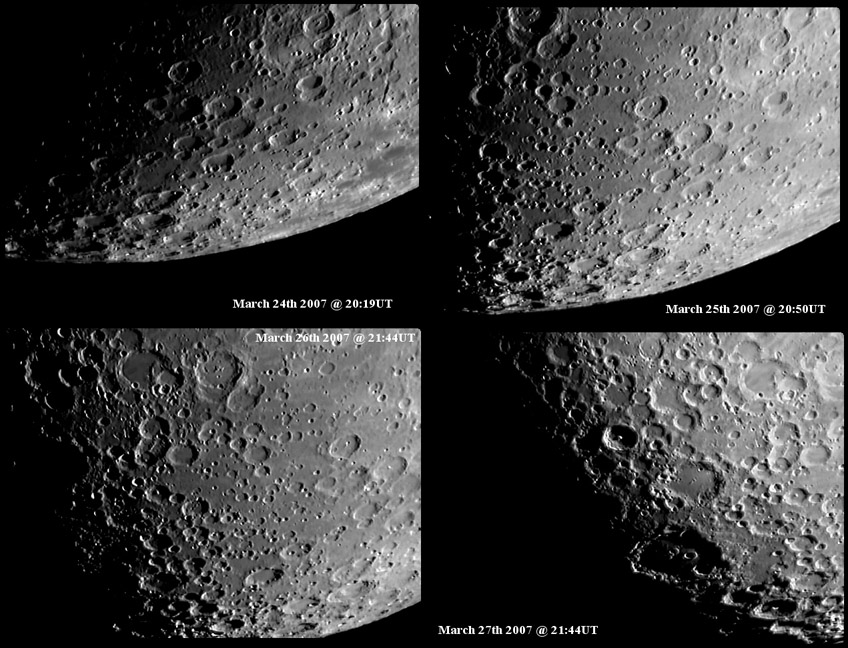|
|
| (12 intermediate revisions by the same user not shown) |
| Line 1: |
Line 1: |
| | __NOTOC__ | | __NOTOC__ |
| | =A Modest Beginning & a Difficult Challenge= | | =A Modest Beginning & a Difficult Challenge= |
| | + | <!-- Start of content --> |
| | + | <div class="post" id="post-1210"> |
| | | | |
| − |
| + | <div class="storycontent"> |
| − | <div class="post" id="post-1210">
| + | <p>[[File:Mosaic_of_terminator_March_2007LPOD.jpg|Mosaic_of_terminator_March_2007LPOD.jpg]]<br /> |
| − |
| |
| − | <div class="storycontent">
| |
| − | <p>[[File:Mosaic_of_terminator_March_2007LPOD.jpg|Mosaic_of_terminator_March_2007LPOD.jpg]]<br />
| |
| | <em>images by [mailto:johnmcconnell9929@hotmail.com John McConnell], Northern Ireland. </em></p> | | <em>images by [mailto:johnmcconnell9929@hotmail.com John McConnell], Northern Ireland. </em></p> |
| − | <p>Almost from their very beginnings, image atlases of the Moon differed from drawn ones in depicting each area under different illumination conditions. For example, the early photograhic atlas by [http://www.lpod.org/cwm/Timeline/1900-60/1903Pickering-TheMoon.html Pickering] showed each area under multiple lighting angles, as did Kuiper’s later <em>Photographic Lunar Atlas</em> and <em>[http://www.lpod.org/archive/LPOD-2004-08-11.htm Consolidated Lunar Atlas]</em>. Not even the monumental <em>[http://www.lpod.org/cwm/Timeline/1800s/1878-Schmidt.html Charte der Gebirge des Mondes]</em> drawn by Julius Schmidt after 34 years of observing could depict the lunar surface under different angles of illumination. John’s small series of images show the ease of gathering images for a multiphase atlas - simply be lucky with the clouds and take images every night! Even small scale images such as these illustrate how the impression of a crater changes as the terminator moves further away, night by night. This makes me think of a project: image a feature - say Copernicus - at relatively large image scale every night of a lunation. Using [http://inet.uni2.dk/~d120588/henrik/jim_ltvt.html" LTVT], images taken at slightly different scales and with different librations can be rectified to a uniform perspective. Put them together as a video and then enjoy seeing the changes through the month. And its not even necessary to wait until all 28 images are available to begin assemblying the movie - even a fade between low Sun and full Moon views would be informative. Perhaps a future digital atlas of the Moon will include a month of views for every area… </p> | + | <p>Almost from their very beginnings, image atlases of the Moon differed from drawn ones in depicting each area under different illumination conditions. For example, the early photograhic atlas by [http://www.lpod.org/cwm/Timeline/1900-60/1903Pickering-TheMoon.html Pickering] showed each area under multiple lighting angles, as did Kuiper’s later <em>Photographic Lunar Atlas</em> and <em>[[August_11,_2004|Consolidated Lunar Atlas]]</em>. Not even the monumental <em>[http://www.lpod.org/cwm/Timeline/1800s/1878-Schmidt.html Charte der Gebirge des Mondes]</em> drawn by Julius Schmidt after 34 years of observing could depict the lunar surface under different angles of illumination. John’s small series of images show the ease of gathering images for a multiphase atlas - simply be lucky with the clouds and take images every night! Even small scale images such as these illustrate how the impression of a crater changes as the terminator moves further away, night by night. This makes me think of a project: image a feature - say Copernicus - at relatively large image scale every night of a lunation. Using [http://inet.uni2.dk/~d120588/henrik/jim_ltvt.html LTVT], images taken at slightly different scales and with different librations can be rectified to a uniform perspective. Put them together as a video and then enjoy seeing the changes through the month. And it's not even necessary to wait until all 28 images are available to begin assemblying the movie - even a fade between low Sun and full Moon views would be informative. Perhaps a future digital atlas of the Moon will include a month of views for every area… </p> |
| | <p>[mailto:tychocrater@yahoo.com Chuck Wood]</p> | | <p>[mailto:tychocrater@yahoo.com Chuck Wood]</p> |
| | <p><strong>Technical Details:</strong><br /> | | <p><strong>Technical Details:</strong><br /> |
| Line 14: |
Line 13: |
| | </p> | | </p> |
| | <p><strong>Related Link:</strong> | | <p><strong>Related Link:</strong> |
| − | <p />
| + | Gassendi under [[March_28,_2006|simulated iluminations]]</p> |
| − | Gassendi under [http://www.lpod.org/?m=20060328 simulated iluminations]</p> | + | <p><b>Yesterday's LPOD:</b> [[June 25, 2007|A Tradition Lives On]] </p> |
| − | <div align="center"><em>LPOD earns a commission when you buy ANY book from Amazon thru [[LPOD]]<br /> | + | <p><b>Tomorrow's LPOD:</b> [[June 27, 2007|A Small Pix and a Short Story]] </p> |
| − | </em></div></p> | + | </div> |
| − | </div>
| + | <p> </p> |
| − |
| + | <p> </p> |
| − | | + | <p> </p> |
| − | ---- | + | <!-- End of content --> |
| − | ===COMMENTS?===
| + | {{wiki/ArticleFooter}} |
| − | Click on this icon [[image:PostIcon.jpg]] at the upper right to post a comment.
| |




